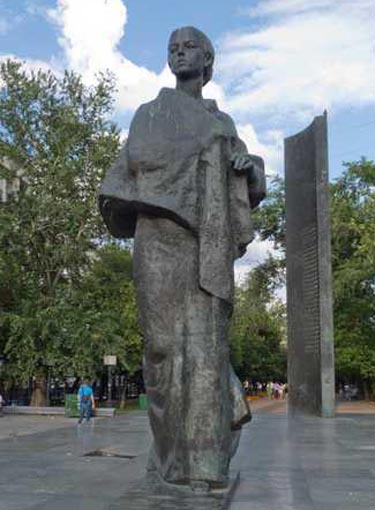Artist:
Yekaterina Belashova
Title:
Nadezhda Konstantinovna 'Nadya' Krupskaya
Year:
1977
Adress:
Sretenskiy bul'var
www.wikipedia.org:
Nadezhda Konstantinovna 'Nadya' Krupskaya (Russian: Наде́жда Константи́новна Кру́пская, scientific transliteration Nadežda Konstantinovna Krupskaja) (26 February [O.S. 14 February] 1869 – 27 February 1939)[1] was a Russian Bolshevik revolutionary and politician (she served as the Soviet Union's Deputy Minister of Education from 1929 until her death in 1939), and the wife of Vladimir Lenin from 1898 until his death in 1924.
She was born to an upper-class but impoverished family. Her father was a Russian military officer, a nobleman of the Russian Empire. Nadya's father, Konstantin Ignat'evich Krupski (1837–1897), was orphaned in 1847 at age nine. He was educated and given a commission as an infantry officer in the Russian Army. Just before leaving for his assignment in Poland he married Nadya's mother.
In October 1896, several months after Lenin was arrested, Krupskaya was also arrested. After some time, Lenin was sentenced to exile in Siberia. They had very little communication while in prison but before leaving for Siberia, Lenin wrote a"secret note" to Krupskaya that was delivered by her mother. It suggested that she could be permitted to join him in Siberia if she told people she was his fiancée. At that time, Krupskaya was still awaiting sentencing in Siberia. Krupskaya was permitted to accompany Lenin but only if they were married as soon as she arrived.
In her memoirs, Krupskaya notes"with him even such a job as translation was a labour of love".[10] Her relationship with Lenin was more professional than marital, but she remained loyal, never once considering divorce.
Krupskaya's political life was active: she was anything but a mere functionary of the Bolshevik faction of the Russian Social Democratic Labour Party from 1903.
Krupskaya was a committed Marxist for whom each element of public education was a step toward improving the life of her people, granting all individuals access to the tools of education and libraries, needed to forge a more fulfilling life. The fulfillment was education and the tools were education and library systems.
www.vanderkrogt.net:
Bronze statue with two 5 m high pylons with quotations from Krupskaya on a podium of 9 x 18 m and 60 cm high.
Nadezhda Konstantinovna 'Nadya' Krupskaya (Russian: Наде́жда Константи́новна Кру́пская, scientific transliteration Nadežda Konstantinovna Krupskaja) (26 February [O.S. 14 February] 1869 – 27 February 1939)[1] was a Russian Bolshevik revolutionary and politician (she served as the Soviet Union's Deputy Minister of Education from 1929 until her death in 1939), and the wife of Vladimir Lenin from 1898 until his death in 1924.
She was born to an upper-class but impoverished family. Her father was a Russian military officer, a nobleman of the Russian Empire. Nadya's father, Konstantin Ignat'evich Krupski (1837–1897), was orphaned in 1847 at age nine. He was educated and given a commission as an infantry officer in the Russian Army. Just before leaving for his assignment in Poland he married Nadya's mother.
In October 1896, several months after Lenin was arrested, Krupskaya was also arrested. After some time, Lenin was sentenced to exile in Siberia. They had very little communication while in prison but before leaving for Siberia, Lenin wrote a"secret note" to Krupskaya that was delivered by her mother. It suggested that she could be permitted to join him in Siberia if she told people she was his fiancée. At that time, Krupskaya was still awaiting sentencing in Siberia. Krupskaya was permitted to accompany Lenin but only if they were married as soon as she arrived.
In her memoirs, Krupskaya notes"with him even such a job as translation was a labour of love".[10] Her relationship with Lenin was more professional than marital, but she remained loyal, never once considering divorce.
Krupskaya's political life was active: she was anything but a mere functionary of the Bolshevik faction of the Russian Social Democratic Labour Party from 1903.
Krupskaya was a committed Marxist for whom each element of public education was a step toward improving the life of her people, granting all individuals access to the tools of education and libraries, needed to forge a more fulfilling life. The fulfillment was education and the tools were education and library systems.
www.vanderkrogt.net:
Bronze statue with two 5 m high pylons with quotations from Krupskaya on a podium of 9 x 18 m and 60 cm high.



